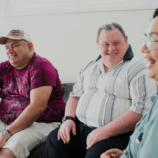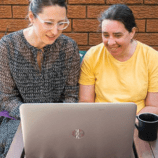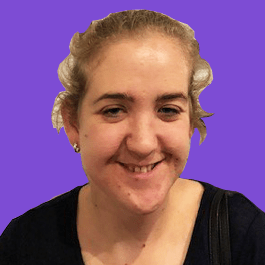Click on the Green play button to listen to the podcast on this website.
View Transcript
Painting for love and a living transcript
Fiona
Hi everyone. And thanks for listening to Visibility, the monthly podcast produced by CID, the Council for Intellectual Disability.
Fiona
Here, we will be telling our stories, and exploring some of the issues that impact people with intellectual disability. To find out more about our work visit www.nswcid.wpengine.com.
Now, settle in and enjoy.
Music
[CID’s podcast tune]
Adele
In the spirit of reconciliation, the Council for Intellectual Disability acknowledges the Traditional Custodians of country throughout Australia and their connections to land, sea and community. We pay our respects to their elders past and present and extend that respect to all aboriginal and Torres Strait Islander peoples today.
Alex
Hello and welcome to Disability, the podcast for Council for Intellectual Disability. Today, we’ll be talking with Lauren Kerjan about her experiences as a person with intellectual disability who is also a visual artist. My name is Alex Elliott. I will be your host today.
With me is my co-host Adele Tashkin.
Adele
Hi, Alex. Thank you. Great to be with you again. Welcome, Lauren. It’s so great to chat with you today.
Lauren
Yeah, thank you. Hi. Thanks for chatting with me today about what I do.
Alex
So, Lauren, I understand you’re a painter.
Lauren
Yes.
Alex
Can you tell me how you got into that?
Lauren
I got into that when I enjoyed at school, and I’ve done it for a while. It was my favourite subjects.
Alex
So you mentioned an art class, did a teacher take an interest or encourage you?
Lauren
I just got encouraged by some of the staff members and I looked at how other members do their artwork as well. So there is kind of different ways of doing it.
Adele
Thanks, Lauren. So hearing about how you were encouraged at school, I’m wondering about your family and friends as well. Did they sort of encourage you to, you know, continue your painting and your artwork?
Lauren
Yes, I did. They seem to like encouraging me to do a lot of art and stuff. My grandmother is an artist and did a lot of watercolour painters and stuff, so I looked at hers and thought I could do some watercolours too, and all the materials too.
Alex
So I understand that you also like to draw. Do you find that separate to painting? Do you sketch before you paint?
Lauren
Yeah, I usually sketch before I paint. I sketch it out first and then think of what colours to go on the artwork and then the chalk pastel you kind of separate to painting, which I like to draw as well.
Alex
And do you use apps on a tablet to paint or draw?
Lauren
I use Photoshop. I have my own Photoshop license and I do a bit of digital art and I have that Lego Wacom tablet, which I sketch on sketching a sketching kind of tablet that goes on because of Photoshop to do a bit of sketching on there, too.
Alex
And what materials do you like? Do you like to enjoy?
Lauren
My favourite one is the smudging of the chalk clusters.
Adele
That sounds so beautiful. You can get such great colours from chalk as well. Yeah.
Lauren
And just like blend cleansing too, a lot of stuff as well. So yeah.
Alex
I guess the big question is, have you had anything displayed in the gallery yet? Have you had any? Have you sold anything?
Lauren
Yeah, I’ve sold apply a few quite a few artworks over the years and I was I was in the art gallery of New South Wales on a mural with six other artists.
Alex
That’s the dream.
Lauren
Yeah. And that is the dream.
Alex
Have you had any commissions in your life?
Lauren
Yeah, I’ve had quite a few commissions, especially when I was at Studio A, I did an artwork for Barangaroo, the Wetpac building, and I did like, see all the companies, to try to encourage some of us. Yeah.
Adele
It sounds like Lauren, not only you’re working at us, but you’re a successful working artist. Yeah, but I think, yeah, whether you’re an artist or not, we probably all realize that that takes a lot of, you know, all the effort to you need to have a lot of self-belief.
Do you need to really believe in yourself to continue doing your work?
Lauren
The belief in like trying to get my work out there? And yes, believe me, believe me.
Adele
Because you’re working artist Lauren. And again, you’ve you know, you’ve put all of this this time and effort and belief, and you have this great support from family and friends. Do you consider yourself a successful artist?
Lauren
Yes, I do. I do think I’m a successful artist and I enjoy doing it. It’s fun doing it.
Alex
What type of genre would you describe your paintings, like if you could name an artist you think that you like, who would pay?
Lauren
Things like that really have a favourite, but I got the inspiration of a go, try and go to the art gallery, sometimes to have a look at other artists like exhibitions and things.
Adele
Like maybe your grandmother was if she was a watercolour artist. Yeah. Did you think that she was an inspiration to you when you were younger, knowing that your that you had a grandparent who was an artist?
Lauren
Yeah, I think so. She was my inspiration as well as the other side as well.
Alex
Do you think that you look through art through the perspective of a person with a disability? Or did you find it’s a very welcoming area.
Lauren
Pretty well. It was like a welcoming area.
Alex
That’s nice to hear.
Adele
Yeah, isn’t it? So tell us, Lauren, what are some of the reasons that you love being an artist?
Lauren
It’s being creative, and I love different colours.
Adele
It’s a way for you to express the things that you find beautiful. Yeah, yeah, that’s very cool. What do you hope that people might sort of feel or think when they look at perhaps one of your paintings?
Lauren
A lot of my family, friends and stuff, and they think some like more like realistic. But in a twist of, like, detail and a lot of patience and stuff in some of the artwork.
Adele
Things are hoping people will see the amount of sort of passion and effort and skill that you’ve put into your work. Yeah. I mean, would you call painting particularly fun or is it sometimes frustrating being a creative person, perhaps if you get blockages and things like that?
Lauren
Sometimes if I have a project due in a certain amount of time I have to put on the pressure on a bit. Sometimes I get frustrated with like the paint, but not too much.
Alex
So, if you were talking to a person with an intellectual disability who said, I want to become an artist like you, what are some tips that you would give them?
Lauren
I’ll say, like going to an art class and see what they do and give it a try and see if you like it or not. Have a go and you don’t have to choose it if you don’t want to.
Alex
And what do you want everyone to know about artists with intellectual disabilities?
Lauren
All I have to say that is fun, and it’s a good way to take your mind off what is in your head and be creative. And yes.
Adele
It’s such great advice to encourage people to pursue the things that they want to do. Are you part of a community of artists, Lauren?
Lauren
Yes, I’m in a community of artists.
Adele
Do you then practice your art with them and work together? Sort of so that you’ve got a supportive, creative environment?
Lauren
Yeah. We have a location of a lot of the other artists and kind of different, but we just thought we still have close group artworks and things throughout the year and just do the one thing sometimes.
Adele
And would you say that you like you’ve spoken about Studio A and being able to work in that collective? Do you think that that’s made it more realistic for you to be a working artist?
Lauren
Yes, it has been a life changer because when I was at Studio Answers, I really had like 11 exhibitions a year. And now it’s like I have some looks like out in the other mainstream exhibitions and all that has helped me to enjoy it and make money out of it.
Adele
A lot of artists have another job. So do you have certain days a week where you dedicate to your artwork and then other days a week where you might do another job?
Lauren
I do like three days a week, Mondays, Tuesdays and Thursdays, and then on Wednesdays I help at a childcare center. Yeah, doing a bit of art with them stuff.
Adele
Oh, that’s a lovely thing. So you’re within your practice as an artist? Yes. And then subsidizing your income as many artists are required to do, but you still get to share your skills with another generation. Yeah. When you go and work in the childcare center, that’s really lovely.
Lauren
Yeah.
Adele
This is really interesting. We’re now going to take a quick break before hearing more about some of the complexities of being an artist with an intellectual disability.
Fiona
You’re listening to Visibility, the podcast produced by the Council for Intellectual Disability. If you enjoyed this episode, you can support us for viewing us through Apple Podcasts or your favorite listening app.
Alex
Welcome back, everyone. You’re listening to kids podcast visibility. And today we’re chatting with mine. She’s filling us in on the joys and challenges of being a visual artist with an intellectual disability. From what I have seen of your paintings, there’s a lot of nature.
There’s a lot of landscapes and animals and stuff. So have you developed this image in your head like you’ve woken up and just gone to Giraffe and at night or something like that? Or has it developed over a few days?
Lauren
I love it all landscapes and nature. Like pretty much going to my thing. But then I sometimes I go outside and have a look at the plants and animals and think, maybe I should do like a plant or a turtle or a landscape.
And sometimes I just have a look at some photos on the internet, but pretty much I just go outside and have a look what I should draw.
Alex
So watching these animals is that is it just Australian sort of landscapes? Or do you what David Attenborough and you know, something with an African vibe.
Lauren
Any colour of light and kind of landscapes. And that was enough to be like Australia could be like one of a artwork that I went to Japan. I had a winter landscape that I did over there and like I did quite a few other ones throughout the holidays as well.
So the different other countries around the world and animals to.
Alex
So how long does it take your paintings?
Lauren
Depends on how big I want it to be, depends on how much time I would spend on it. Some of them I can do in a day like some of the watercolour ones and stuff, but pretty much like over a period of time.
Adele
So, Lauren, just talking a little bit more about your practice. Can you tell us, you know, what’s the day in the life of Lauren, the artist? How do you start your morning? What does your day look like?
Lauren
We start at 9:30 and I work up until about 12:00 to 1:00 and then 1:30-3. I’ve got a lot of patients, so I’d if I wanted to. If I’m focused in what I want to do, I just I have a lunch break, or sometimes I have a little break, yeah.
Adele
It is definitely a job. It’s a 9:30 to 3 job where you were. You dedicating your time to your artwork and getting your pieces completed. Do you carry around like a sketch pad and, you know, pencils and sort of, you know, maybe stuff in a park and do a sketch or just throw something down when you think of it?
Lauren
Yeah. When I’m like, when I’m not at the studio, I, I just sketch in hand and pencil one or a rub. I just go outside and draw what I want to draw. But this year, there’s usually like books of like other artists to have walk out to see what I like to do.
Adele
So Lauren, your artwork, I mean, you, you work on it each week. You carry around the sketch pad, you work in studios, you work in nature. Would you say it’s a way for you to express what’s inside of you and that if you didn’t have that, that might not be as happy a life for you.
Lauren
It just shows makes me feel happy and excited that I’ve got some people who love my art and those trying to get me killed and commissions and try to sell the art. If it wasn’t for art and stuff, I would just love to find another job. And so, to find some jobs with people with disabilities sometimes.
Adele
Sounds like art more than just a job for you. It’s your passion and how you have to be in the world to be happy.
Lauren
Yeah.
Adele
So, Lauren, where we can any of us go and have a look at all of your beautiful artwork online and maybe make a purchase if that’s what we wanted to do?
Lauren
If you wanted to make a purchase, there is an organization like the share website or there’s someone in their Instagram and Facebook at Studio A and some artists there and also look at the page Hashtag Instagram Lauren Kerjan: https://www.instagram.com/explore/tags/laurenkerjan/
And it is part of the way it has all my art coming artwork and things that they post.
https://www.studioa.org.au/
Adele
So the best way to have a look at your artwork is to check out Studio A here in Sydney and also you have an Instagram account.
Lauren
Yeah.
Adele
So that’s Lauren Kergan, K E R G A N. Yeah. And you have a Facebook, did you say as well, Lauren?
Lauren
Studio A has a Facebook page as well:
https://www.facebook.com/studioasydney
Adele
Studio A Facebook. Excellent. So if you want to check out Lauren’s work, check out Studio A both on Facebook and on the internet (https://www.studioa.org.au/) and check out Lauren Kerjan on Instagram.
Alex
Thanks, Lauren, for joining us today and sharing such incredible insights to those listening. Thank you as well. Please join us next month for another episode in our arts and culture series where we will be discussing acting with intellectual disability.
Fiona
You can support our podcast by leaving a review on Apple or your listening app of choice. Until next month.
* The content and views discussed in this podcast series are those of the individuals involved. They are not necessarily condoned by, or, are the views of the Council for Intellectual Disability or its employees.



 1800 424 065
1800 424 065 











